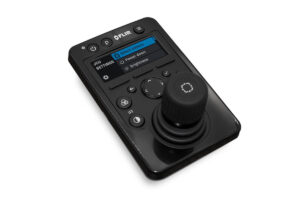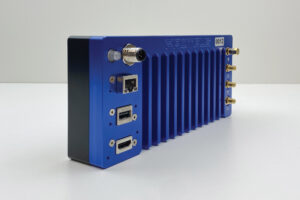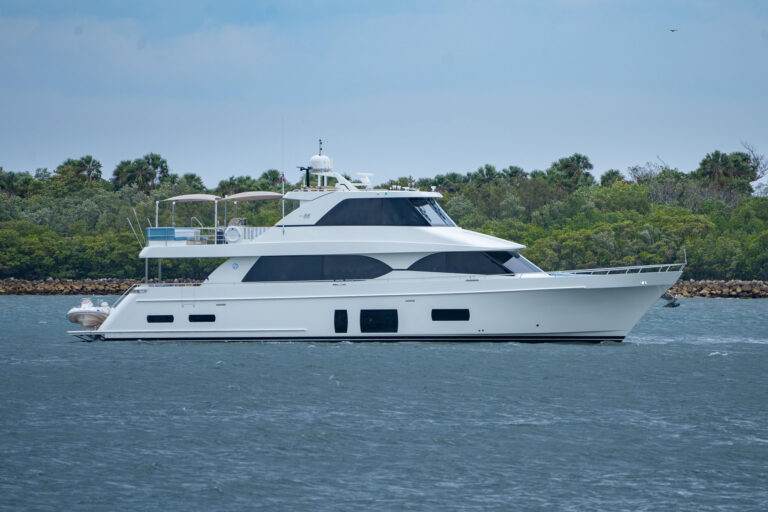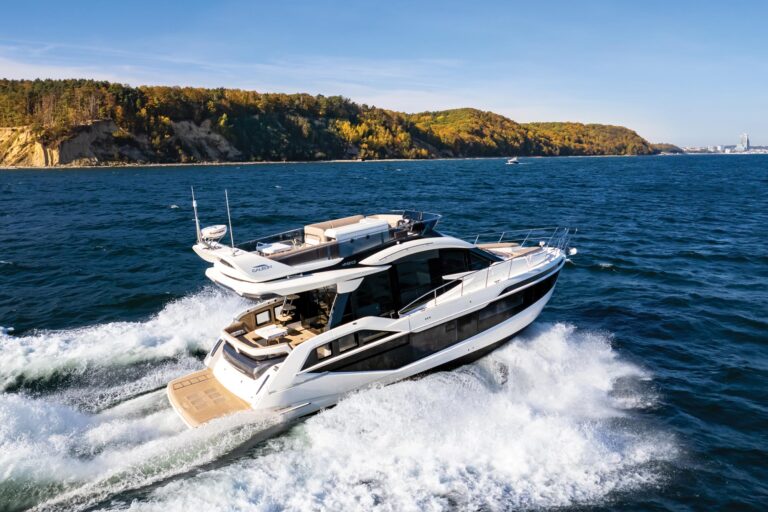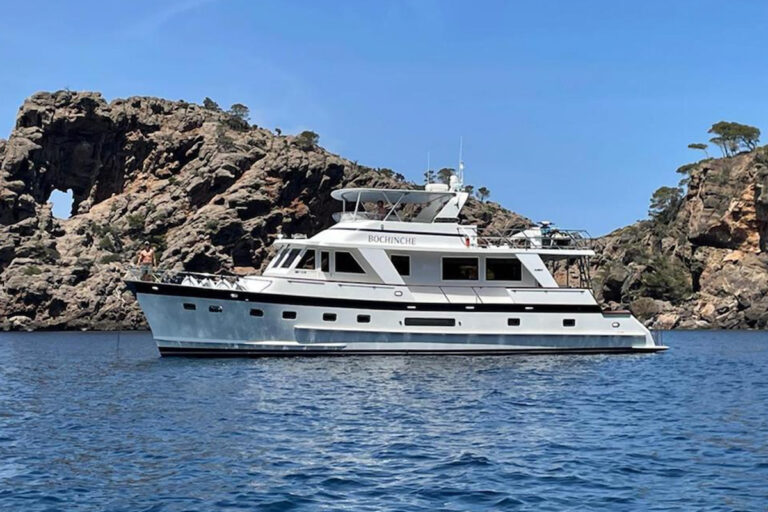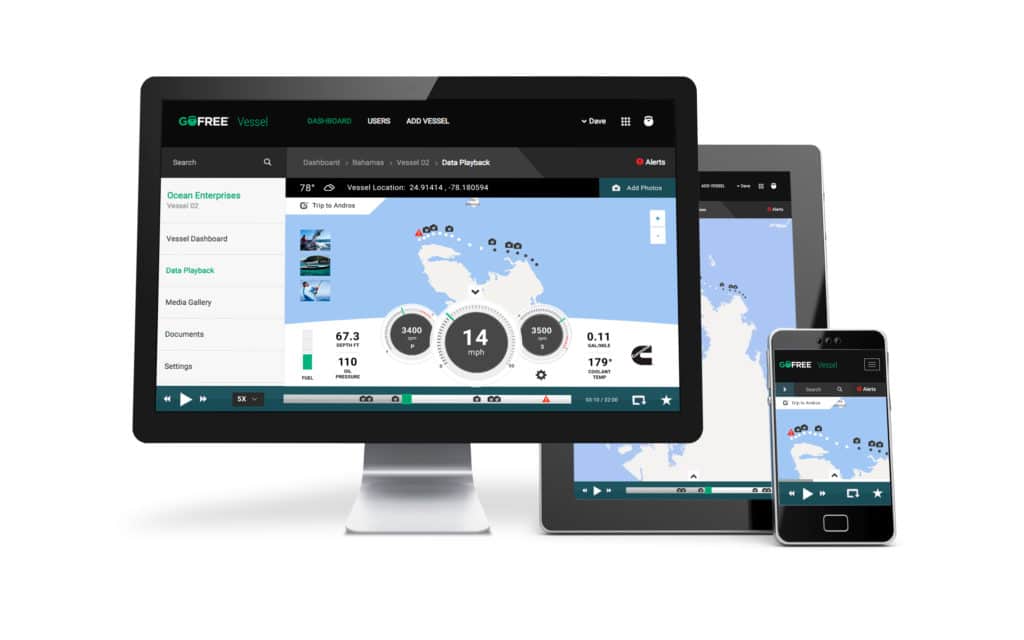
Few priorities rank higher in my life than finding time to sail with my dad, a challenge compounded by the geographical reality that my wife and I live in Seattle while my parents call Connecticut home. All parties put great effort into our too few and far between sailing days, so our frustration was understandable that (perfect) fall day when the boat’s engine quit just as we were leaving the mooring. A clogged fuel filter was the culprit, but we squandered valuable time troubleshooting the problem. We had the necessary spares, but I wondered if there wasn’t a faster way to diagnose onboard issues. Flash-forward almost two years, and GoFree’s new Track modules, which are compatible with Simrad products, provide that capability plus much more.
Telematics refers to wireless technologies that send data to cloud servers — and to mobile devices and computers — in real time. GoFree’s new Track units provide some of the boating world’s first telematics services. Track modules interface with a yacht, its systems and its sensors to collect data that’s shared wirelessly with the cloud to provide enhanced security, service and social media benefits. While these are still nascent days, the future implications are huge.
Under the hood, Track modules contain a GPS to provide vessel location information, 10 megabytes of memory space (see sidebar) and — model depending — a cellular modem and Wi-Fi transmitter. An internal battery enables telematics updates for 30 days, sans top off. Should external power drop, Track cuts its transmission rate to once per day.
GoFree makes two versions: Track-WiFi can connect via land-based Wi-Fi hotspots or via smartphone or cellular-enabled tablets (mobile hotspots), while Track-CellFi can access both Wi-Fi hotspots and cellular networks. Both Track units offer Bluetooth connectivity and can be paired with an optional Track-Sat antenna, which lets Track transmit via the Iridium satellite network (available in the third quarter of 2016) when operating outside of cellular coverage. In all cases, Track automatically chooses the least expensive data-uplink option.
Both GoFree Track modules are designed to interface with a yacht’s systems and instruments via hardwired connections that include NMEA 2000, as well as two CAN (J1939) ports for “talking” with diesel engines (some engine manufactures prefer engines be kept on separate data buses). Track isn’t currently NMEA 0183 backward-compatible, but it can interface with various onboard sensors to monitor and report their status to the cloud. For example, Track can constantly monitor for abnormal bilge-pump activity, lost shore-power connections, atypical onboard temperatures and low house-battery voltage, as well as engine metrics including hours, rpm, battery levels, and oil pressure and temperature. Additional sensors can be added as needed.
Depending on module and data plan, owners can use smartphones, tablets or PCs to check their vessel’s location and monitor the status of door and window sensors, as well as networked onboard systems. Also depending on module and data plan (GoFree partnered with Vodafone to support cellular communications), Track can push this data to emails, sending owners an alert if a security sensor is tripped or if an alarm activates.
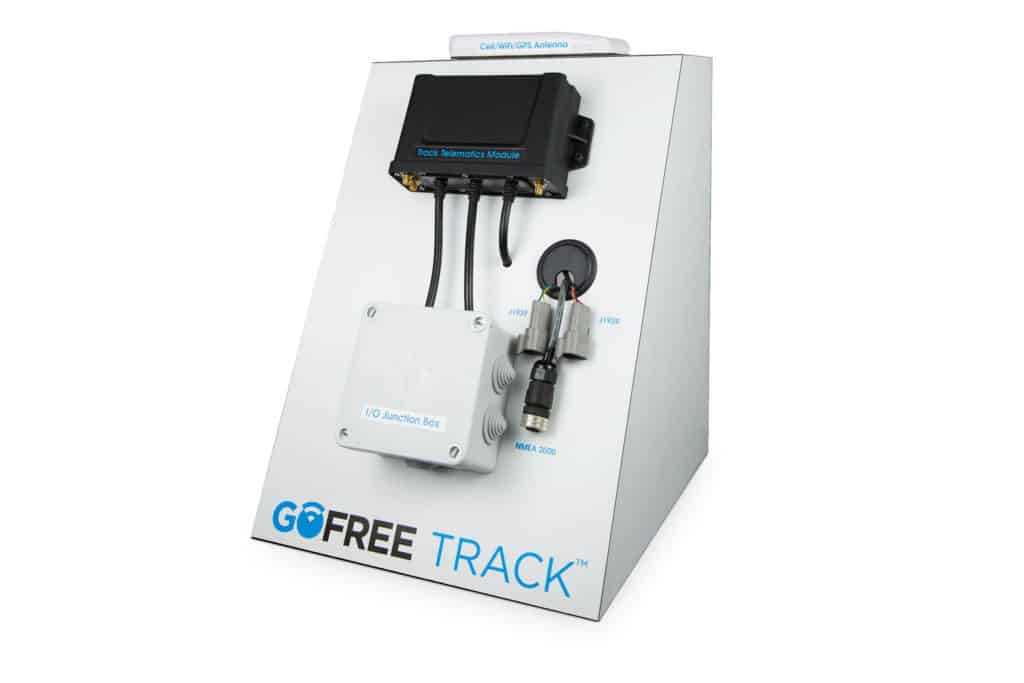
Provided that no alarms are active, Track aggregates information and periodically transmits its log file to the cloud server. Should an alarm trip on board, Track switches to monitoring mode and reports its updates to the yacht owner much faster (see sidebar). The GoFree cloud texts a designated smartphone(s) so that an owner can see, via the GoFree Vessel app or web interface, if the alarm is false or if a condition requires attention, either wirelessly or in person.
“Track connects a valuable asset to enhance how it’s supported and serviced,” says Phil Gaynor, GoFree’s senior telematics product manager. “The currency of our customers is free time. If there’s an alert that someone should be advised on, it can be sent to the owner or [his] designated service provider, which can help accelerate service with information.” Track offers remote digital-switching capabilities, including the ability to turn on/off three custom-configurable onboard switches, letting Track control lights, bilge pumps or even cabin heaters. (This could require adding an electrical relay to handle loads; Track controls the switch or relay, not the system itself.) Track’s security-alarm system can also be controlled remotely via smartphone app or the website.
Interestingly, Track also enables enhanced shoreside services. For example, an owner can set a geofence around a harbor entrance so that when his yacht returns after a day of fishing, an alert is sent to the marina operator’s smartphone requesting he meet the boat with ice.
Finally, Track offers a social-media component that allows users to add personal content to a trip recording, such as photos, which are time- and (sometimes) geo-stamped, or even notes about those secret fishing grounds. This information can be shared with family or friends, and it can be exported in a format that allows a user’s online community to view the trip on Facebook.
As for privacy, GoFree is interested in data, not personal secrets. “Data isn’t shared without permission,” Gaynor says. “It’s saved to a cloud, but owners will need to opt in to share their data.”
For example, owners can share data such as engine hours with third-party service providers or insurers, but only owners (or charter clients with an owner’s permission) can access personal data like photographs. All data is time-sorted into calendar-searchable time slices, or as trip reports. Owners can review these trip reports via the app or website, where the data is displayed on a dashboard-like user interface.
Comms with the Clouds
How much data does Track use? Provided no alarms are active, Track aggregates and uploads roughly half a megabyte of data per day, but it can store 10 megabytes locally (unneeded data is overwritten). Should an alarm trip Track into monitoring mode, the device immediately transmits the full 30 seconds of system or sensor data gathered before the alarm tripped, as well as the 30 seconds afterward. Track then transmits data as needed until the alarm is deactivated.
GoFree Track modules begin shipping this summer, so this technology hasn’t yet hit most marinas. But if user-generated cartography is any indicator of boaters’ willingness to share data in return for improved bathymetric information, then the odds are excellent that telematics will become an important part of the boating landscape.
GoFree will likely support cartography downloads and Insight Genesis (GoFree’s user-generated cartography) updates eventually, but right now, these files are too large for Track’s connectivity. Still, Track’s existing capabilities could have quickly diagnosed our clogged fuel filter on that perfect day in 2014, saving my family valuable boating time.

